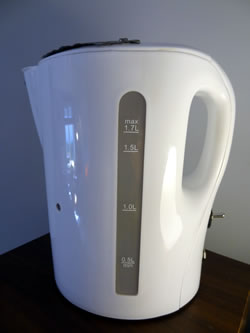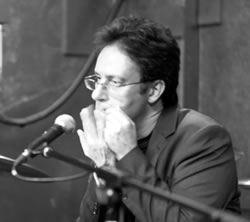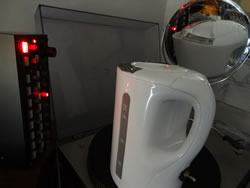A Voyage Around My Boilophone
A personal approach to playing and recording with a unique DIY electronic instrument
What is a Boilophone?
The Boilophone is a homemade synthesizer housed in a white plastic kettle. It was created by Joe Paint, (a.k.a. The Green Dungeon Alchemist), a UK-based builder and inventor of unique sound machines made using recycled and discarded materials. It features his patented C493 Otrillodyne circuit and contains, as Joe explains, “3 oscillators, combined by 2 different methods of signal heterodyning to produce interstellar cosmic electronic sounds!” (Paint 2015)
The instrument has two light sensors centrally mounted in the body, one on either side at the same height near the front. In addition, there are two metal touch plates, contact controllers, screwed onto the permanently sealed kettle lid. The device is powered by a 9 V battery and has a 1/4-inch mono audio output. Boilophone produces unapologetically raw streams of electronic sound the instant the on/off toggle switch is activated. Sound manipulations result from the combined output of the three oscillators’ signal heterodyning, influenced by gestural and tactile play between the light sensors and the touch plates.
Playing a Boilophone
The output of the Boilophone is volatile and highly unstable. It is hypersensitive to its light environment and handling. The raw sound of heterodyning oscillators produces a line in continuous flux; a wailing atonal choir mutates into a single stuttering deep bass blip, through simultaneous arcs of timbral, rhythmic and pitch transformation, before I’ve even managed to sit down comfortably to start playing it!

The Boilophone is primarily responsive to light, therefore some kind of gestural technique to control the amount and nature of light exposed to the LDRs to influence sound generation has to be investigated. After playing a while, some broadly predictable outcomes can be recreated with certain gestures; however, introducing the influence of the metal touch plates seems to shatter any predictability.
The touch plates themselves are much more reactive to moistened fingers than dry, the degree of moistness producing different outcomes. Other factors, like the amount of surface area of finger in contact with the plates, or finger pressure, also seem to affect behaviour profoundly and in mainly very chaotic ways. Any performance with the Boilophone will have to be a free improvisation, as there can be no pre-meditated starting point or point of return, and no way of guaranteeing any kind of predictable development. This, for me, presents a particular kind of musical challenge that I greatly enjoy.
In order to create a performance, or attempt to improvise with other musicians using the Boilophone, I would need to find ways of influencing control over its volatile and unstable nature.
Volume
The first problem to solve is acquiring expressive control over the level of audio output, easily achieved by introducing a passive volume pedal between the Boilophone audio out and loudspeaker. The addition of the pedal now affords some ability to create space and dynamics, and consequently a degree of phrasing of the output. I noted how the sounds seemed to mean very different things to me psychologically when expressed at different and modulated volumes.
Expressive command over volume is the most primary, powerful and profound tool available to the electronic musician.
For example, the most violent of sounds at the lowest levels became seemingly poignant and vulnerable in nature, rather than charged and aggressive. I explored the possibilities of playing a whole piece simply by contouring the volume of a simple drone. (I say “simple” — maintaining any degree of stability of pitch and timbre with the Boilophone is rather like sitting very still for a photograph.)
I was now in a process of extrapolating form from the generated sounds and attempting to develop a compositional line as a response to my immediate feelings about them.
These initial investigations reaffirmed my belief that expressive command over volume is the most primary, powerful and profound tool available to the electronic musician.
Spout
After experimenting for a while with new possibilities offered by the volume pedal, I began to think of other ways I could bring expression to Boilophone play. The next thing I would automatically consider with a synthesizer of any sort would be the introduction of some kind of filter into the signal path.
With both hands fully engaged in steering the direction of audio flow (LDRs and Touch Plates) and one foot dedicated to controlling dynamics, I’m left with a spare foot that I could use with another expression pedal, to control the parameters of my Moogerfooger 101 Lowpass Filter.
I have used this fine filter a lot in the past and know its sound very well. Experimenting with it produced some very pleasing and interesting results worthy of investigation, but somehow the unmistakeable character of the filter seemed to usurp the essential sound of Joe’s original oscillator circuit a little too much, a uniqueness that I wanted to preserve. In addition, trying to control volume simultaneously with filter cut-off (for example) in a musically meaningful way felt unnatural and much trickier than I was expecting.
I did observe real moments of sonic interest using the filter, but my aim had been to add greater expressive control rather than introduce complication and further difficulty. I needed to find a more practical and naturally expressive method of filtering the sound for me. The remaining physical controller or resource at my disposal — aside from my spare foot — is my oral cavity. For some years I have been a performer and collector of Jew’s Harps and Mouthbows (Fig. 2) dedicating myself to exploring expressivity of the human oral cavity with regard to the resonant filtering and enveloping of acoustic harmonic material. In my efforts as an electronic composer I have been simultaneously investigating electronic filtering of mainly non-harmonic, non-acoustic material, and so began thinking of possible ways to bring these two different aspects together.

The more I thought about it, the more I wanted to make my mouth a source for the audio output and effectively become a metaphorical spout for the Boilophone. I started to look at guitar “Talk-box” technology as a possible method for achieving this. A Talk-box directs the sound from an instrument amplifier into the musician’s mouth by means of plastic tube. The Rocktron Banshee offers this possibility in a very simple package containing a mini amplifier, gain/tone control and the signature plastic tube, one end of which is connected to the small speaker of the Banshee, the other end intended to go in the mouth. Definitely worth a try, I thought, and perhaps the only option available, so I took the plunge and acquired one. The Talk-box proved to be a very natural way for me to modify and shape the sound. The same impulses developed playing acoustic mouth-modulated instruments came into play instinctively, even though I was now processing material of a very different nature.
Performing and Recording
At this stage I started to think about the practicalities of performing with the instrument and how things might work with a PA in a gig situation. I thought recording myself playing the instrument might be a helpful way to work through this thinking process and so embarked on a series of test recordings.
Microphone Only — Microphone + Direct Out In Combination
As the audio output was coming from my mouth, I patched a microphone into my mixer and proceeded to record some improvisations into it as if I was capturing a Jew’s Harp or Mouthbow performance. Upon playback, I was happy with the general direction of the resulting recordings, but felt it might be more interesting if I could split the audio after the volume pedal but before the Talk-box. This would create a direct line out without the oral modulations which I could as could use as a foil to the captured-to-microphone material. Having the opportunity to balance these two signals would enable me to restore some of the character of unfiltered and mouth-modulated Boilophone, in much the same way as adjusting the mix knob on a Moog Lowpass Filter.
To create the additional output, I used my Line 6 Echo Park delay pedal, which, even with the effects mix level set to “0”, creates two outputs from a single input: one for the Talk-box and one direct for the amp or mixer.
The effect of the balancing the audio modulated material from the microphone with the direct input sound of the Boilophone produced, as I’d hoped, a much more vivid, powerful and textural presence in the monitors and in my subsequent recording experiments.
Delay
With the delay just being used so far to generate two outputs from one, it soon became irresistible to start bringing in the effect and experimenting with it. At this point, the possibilities of the instrument seemed to bloom. To my ears, the digital delay seemed to extend the Boilophone palette whilst retaining the unique Otrillodyne sound, unlike my earlier Moog LPF experiments. I soon discovered I could trade off decaying delay repeats against fading out with the volume pedal, “feeding” the delay with volume-controlled Boilophone output. I could use the delay to extend, curtail or modify the audio, producing new tones and altered pitches using the delay’s feedback and time controls, and at any desired effect mix level.
MuRF
Having created a mono direct output my next idea was to convert that into a stereo signal using a “MuRF” (Moogerfooger MF-105), an analogue effects pedal that creates unusual filtered stereo animation, with a controllable envelope and rate.
A Brief Summary
The Moogerfooger MuRF has eight resonant filters, each controlled by its own slider. The filters can be animated by a variety of preset patterns. The rate of the patterns can be CV controlled and different rhythmic effects achieved by adjusting the levels of the filters and changing shape of the envelope.
The idea here was that at a live show or in a recording situation, my microphone / Talk-box channel would be mono, positioned within the moving stereo image from the MuRF on the mixer. In addition to a new spatial dimension this would bring to the sound, I intended to “dialogue” my mouth modulations with the characteristic rhythmic enveloping filter sound of the MuRF. My spare foot came into play here to control, most usefully, the rate of the MuRF’s stereo animations. This felt immediately natural in terms of musically coordinating and phrasing with the filtered effects I was creating simultaneously with my mouth.
Mirror-Sequencing
After spending a while thinking how I could maximize utility and expression, capitalizing on the direct output side of things, I started to think more about the instrument itself and different ways it could be played. I was imagining what the heterodyning Otrillodyne sound might be like if it were under some kind of sequencer control. Boilophone has no control voltage or MIDI input for such purposes, but is incredibly sensitive to light with its two LDRs. I reached for my little Korg SQ-1 sequencer and experimented with proximity of its flashing lights to the sensors, and also light conditions in the room.

I was delighted to discover that the Boilophone seemed to very much enjoy being stimulated by the coloured rhythmic flashing of the SQ-1 and even allowed further manipulation through careful interaction with the touch plate controllers. I found the sequence could be also be modified, by playing the sequencer itself, or by obstructing or “feathering in” the amount of light exposed to the LDRs.
In trying to find the optimal position and conditions for exposing the sequencer light output to the Boilophone in order to achieve something of musical interest, I was working with and against the fact that the LDRs occur on opposite sides of the body of the kettle.
This led directly to the idea of using a mirror to reflect the light sequence being exposed to one LDR back onto the other. I found that my shaving mirror — which can be angled and swivelled at will — helped me hone in to find the most reactive and interesting Boilophone responses, as the reflected mirror image of the flashing light sequence seemed to act as some kind of an inversion of the original sequence to the second LDR. The combination of these two versions of the same sequence seemed to wildly excite and animate the Boilophone’s already over-excitable circuitry.
Ready
To recap, the signal chain had now evolved to this:
- Boilophone — Occasional use of sequencer lights (Korg SQ-1) with or without an adjustable shaving mirror, into a passive volume pedal.
- Volume pedal into Line 6 Echo Park delay, creating two line outputs.
- Delay left output to Rocktron Banshee Talk-box to my mouth then into a mono microphone.
- Delay right output to Moog MuRF pedal creating a stereo output.
I settled with this configuration and went on to spend some time familiarizing myself with the instrument’s new playability, endeavouring to find the “edges”, “sweet-spots” and capabilities of its new sound world. I eventually reached the point where I felt ready to attempt something more musical than the test recordings I’d made thus far. I embarked on a series of sessions over two afternoons, from which the following series of pieces emerged. The music was extracted from these sessions, re-ordered and presented with no further editing or overdubbing. Some compression and reverb were added at the final stage of preparing the recordings.
A Voyage Around My Boilophone, Parts 1–8
The completion of these recordings marked the end of my process of preparing for initial solo and collaborative live performances and recordings with the inimitable Boilophone… Ready!
Postscript
Whilst preparing this article, I got back in contact with Joe, creator of the Boilophone, to let him know I was writing something about it. It didn’t take long before our conversation turned to possible ideas for the design and build of an entirely new instrument. We discussed onboard sequencing capability, CV inputs, a few keys, heterodyning oscillators, LDRs and the inclusion of some other original circuitry Joe has been developing. This mysterious new device, (under construction at this time of writing), will be a very different proposition to the basic Boilophone and will no doubt also require the development of an entirely new and idiosyncratic method for playing it.
Bibliography
Paint, Joe. “The Boilophone — It’s Not a Kettle, It’s a Sound Machine!” Matrix Synth. Posted 7 July 2014. http://www.matrixsynth.com/2014/07/the-boilophone-its-not-kettle-its-sound.html [Last acessed 11 November 2016]
_____. Email exchange. July 2016.
Social top